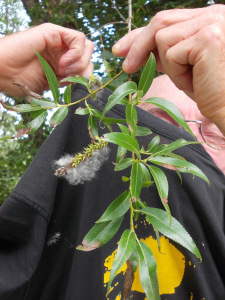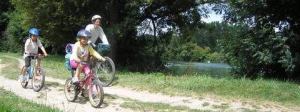Harriet Springbett's Blog, page 5
January 6, 2021
APT 2. Snow in June
(Dordogne Cycle Touring 2/6):
The weather forecast promised perfect cycling temperatures for the June weekend reserved for our first, 2-day session of Abandoned Parent Training (APT).
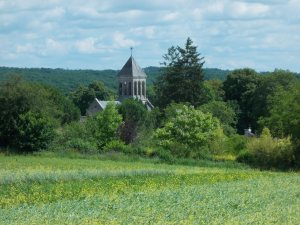 Our destination was the Dordogne – but not the touristy areas of Sarlat and its surroundings. We chose to explore the Dronne valley. This minor river runs in a southwesterly diagonal south of Angoulême and north of Perigueux through (or near) settlements such as Brantôme, Ribérac and Aubeterre-sur-Dronne.
Our destination was the Dordogne – but not the touristy areas of Sarlat and its surroundings. We chose to explore the Dronne valley. This minor river runs in a southwesterly diagonal south of Angoulême and north of Perigueux through (or near) settlements such as Brantôme, Ribérac and Aubeterre-sur-Dronne.
We chose the River Dronne because it was on the page of the map book when we opened it. Also, it seemed to be rural and without particular interest: perfect for peaceful cycling without tourists. We chose our campsite in the same way. The village of Lisle appeared to be large enough to have a bakery and charcuterie for picnic supplies, and the campsite was small.
On arrival, we weren’t disappointed. Lisle is a quiet village and the campsite lay between a pétanque court and the Dronne river, which is about eight metres wide at this point. We pitched our tent in the furthest corner.
And that’s when it started to snow. Look! Within minutes, it was everywhere.
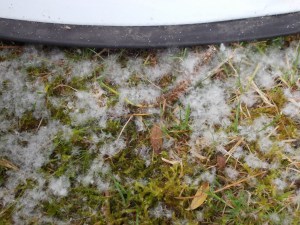
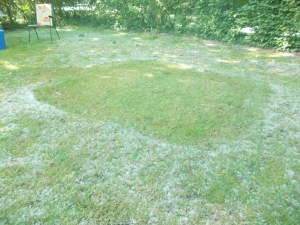
We tried to catch some and keep it to show the kids, then remembered we were on APT training and shouldn’t be thinking about them, about how they were busy studying and learning life skills. They certainly wouldn’t be thinking about us. The snow seems to be pussy willow blossom but maybe you can correct me?
Our major discovery on this part of the Dronne river came on Friday evening, before we’d even mounted our bikes.
A couple of weeks before our trip, some friends had told us about a cool place to hang out on the River Dronne. It was called La Guinguette de Rénamont. Those particular friends are also cool, so we suspected we’d like it.
Are you familiar with guinguettes? They’re a basic riverside bar/restaurant with outdoor tables, festive, often temporary and open only in the summer. I think they might be my new passion.
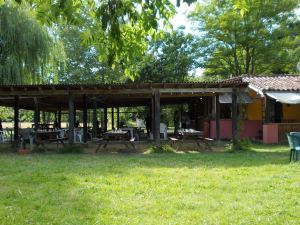
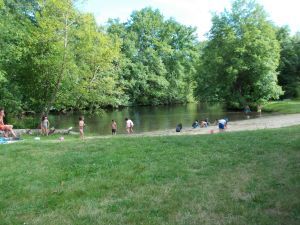
As usual, we only had a large-scale map with us, which is why we decided not to risk cycling and getting lost in the night time (we’d forgotten our bike lights). Instead, we drove to Rénamont. This was just as well, given that we found it at the end of an unlikely track about a kilometre long and down a steep hill.
 What a find! It’s the kind of place where customers talk to each other, where you don’t have to dress up, where people bring their guitars, where you can swim in the river, play pétanque and make new friends.
What a find! It’s the kind of place where customers talk to each other, where you don’t have to dress up, where people bring their guitars, where you can swim in the river, play pétanque and make new friends.
Needless to say, we dropped our plans for a campsite dinner of tinned lentils. Instead, we ordered food and – after a long discussion about kefir and fermentation with the barmaid – a couple of glasses of the local beer.
The beer in question came from a brewery in nearby Marsac called BAM – Brasserie Artisanale de Marsac – and was delicious. We’d have loved to drink more, but we were driving. At least, my partner was.
“Would you like me to drive?” I offered.
He hesitated and then refused. I thought he might suggest buying some bottles to take back to the tent but he didn’t, though I did notice a gleam in his eye.
I should have paid more attention to that gleam. Why? Come back tomorrow and you’ll understand.
Snow in June
(Dordogne Cycle Touring 2/6):
The weather forecast promised perfect cycling temperatures for the June weekend reserved for our first, 2-day session of Abandoned Parent Training (APT).
 Our destination was the Dordogne – but not the touristy areas of Sarlat and its surroundings. We chose to explore the Dronne valley. This minor river runs in a southwesterly diagonal south of Angoulême and north of Perigueux through (or near) settlements such as Brantôme, Ribérac and Aubeterre-sur-Dronne.
Our destination was the Dordogne – but not the touristy areas of Sarlat and its surroundings. We chose to explore the Dronne valley. This minor river runs in a southwesterly diagonal south of Angoulême and north of Perigueux through (or near) settlements such as Brantôme, Ribérac and Aubeterre-sur-Dronne.
We chose the River Dronne because it was on the page of the map book when we opened it. Also, it seemed to be rural and without particular interest: perfect for peaceful cycling without tourists. We chose our campsite in the same way. The village of Lisle appeared to be large enough to have a bakery and charcuterie for picnic supplies, and the campsite was small.
On arrival, we weren’t disappointed. Lisle is a quiet village and the campsite lay between a pétanque court and the Dronne river, which is about eight metres wide at this point. We pitched our tent in the furthest corner.
And that’s when it started to snow. Look! Within minutes, it was everywhere.


We tried to catch some and keep it to show the kids, then remembered we were on APT training and shouldn’t be thinking about them, about how they were busy studying and learning life skills. They certainly wouldn’t be thinking about us. The snow seems to be pussy willow blossom but maybe you can correct me?
Our major discovery on this part of the Dronne river came on Friday evening, before we’d even mounted our bikes.
A couple of weeks before our trip, some friends had told us about a cool place to hang out on the River Dronne. It was called La Guinguette de Rénamont. Those particular friends are also cool, so we suspected we’d like it.
Are you familiar with guinguettes? They’re a basic riverside bar/restaurant with outdoor tables, festive, often temporary and open only in the summer. I think they might be my new passion.


As usual, we only had a large-scale map with us, which is why we decided not to risk cycling and getting lost in the night time (we’d forgotten our bike lights). Instead, we drove to Rénamont. This was just as well, given that we found it at the end of an unlikely track about a kilometre long and down a steep hill.
 What a find! It’s the kind of place where customers talk to each other, where you don’t have to dress up, where people bring their guitars, where you can swim in the river, play pétanque and make new friends.
What a find! It’s the kind of place where customers talk to each other, where you don’t have to dress up, where people bring their guitars, where you can swim in the river, play pétanque and make new friends.
Needless to say, we dropped our plans for a campsite dinner of tinned lentils. Instead, we ordered food and – after a long discussion about kefir and fermentation with the barmaid – a couple of glasses of the local beer.
The beer in question came from a brewery in nearby Marsac called BAM – Brasserie Artisanale de Marsac – and was delicious. We’d have loved to drink more, but we were driving. At least, my partner was.
“Would you like me to drive?” I offered.
He hesitated and then refused. I thought he might suggest buying some bottles to take back to the tent but he didn’t, though I did notice a gleam in his eye.
I should have paid more attention to that gleam. Why? Come back tomorrow and you’ll understand.
January 5, 2021
APT 1. Abandoned Parent Training
(Dordogne Cycle Touring 1/6):
January is a good time to think about summer, a time to look back at the sunny highlights of 2020 and to anticipate the warmer months of 2021.
January is also a time for New Year’s Resolutions. One of mine is to get fit for next summer. I’m sure you agree that doing a blog sprint definitely counts, especially as it’s far too cold outside to do any real sport. So here is the first of six daily, light-hearted posts featuring pictures of summer.
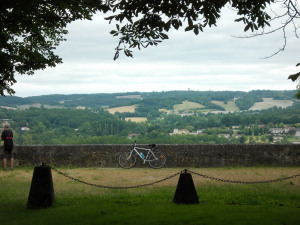 My favourite moments of 2020 revolved around my bike and – by strange coincidence – a couple of local breweries along the River Dronne in the Dordogne.
My favourite moments of 2020 revolved around my bike and – by strange coincidence – a couple of local breweries along the River Dronne in the Dordogne.
These weren’t planned as bike ‘n’ beer trips. Far from it. The aim was to develop a new skill.
Let me begin at the beginning. In June, my youngest child finished high school and enrolled at university. Faced with the prospect of becoming abandoned parents in September, my partner and I decided we needed to do some training to prepare for this change in our lives.
We’re not very good at training. In 2019, for example, we failed miserably to train for our cycling trip to discover the source of the River Charente. We thought that Abandoned Parent Training (commonly known as APT) would be easier to achieve.
But what does APT consist of? And would we be apt for APT? (sorry).
Basically, APT teaches you how to stop your life revolving around your darling offspring.
We’ve always dragged our daughters around with us. Like most parents, we prefer sharing our activities with our kids. This is purely selfish, of course. Discovery is great but when you discover through the eyes of children, it’s ten times more exciting.
So, as part of our Abandoned Parent Training, we decided to make an effort and choose an activity to deliberately exclude them. Come to think of it, our first attempt at excluding our children was the aforementioned River Charente cycling trip in 2019. As I only invented APT ten minutes ago, I’m now wondering whether I devised the Charente trip subconsciously as an APT activity.
Whatever. We had such fun at the River Charente in 2019 that we decided to begin our 2020 APT sessions with another cycling and camping weekend.
Our daughters – who have no idea about APT – just thought we’d finally accepted that they had better things to do with their time than to accompany us. We understand they have important things to do, such as studying and learning how to cook. When they heard our idea, I’m sure they planned to work on those life skills. It seemed they wanted to give their friends the opportunity to develop their life skills alongside them, too. My daughters have exemplary social consciences.
(You see why I need APT? Hardly a sentence goes past without me mentioning my children.)
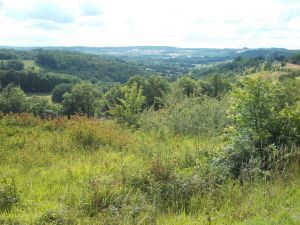 Anyway, in June, soon after the first Covid lockdown was over, we packed our tent, bikes, face masks and hand gel into (and onto) our car.
Anyway, in June, soon after the first Covid lockdown was over, we packed our tent, bikes, face masks and hand gel into (and onto) our car.
We drove across the deserts, mountains and forests of… Well, of the Charente. We thought it best not to be too far from the local hospital in case the kids’ cooking went wrong.
An hour and a half later, we arrived at our first APT destination.
If you’d like to know more about the two Dordogne APT sessions we managed in 2020, come back tomorrow and I’ll share the first instalment with you. There will be photos, I promise.
Abandoned Parent Training
(Dordogne Cycle Touring 1/6):
January is a good time to think about summer, a time to look back at the sunny highlights of 2020 and to anticipate the warmer months of 2021.
January is also a time for New Year’s Resolutions. One of mine is to get fit for next summer. I’m sure you agree that doing a blog sprint definitely counts, especially as it’s far too cold outside to do any real sport. So here is the first of six daily, light-hearted posts featuring pictures of summer.
 My favourite moments of 2020 revolved around my bike and – by strange coincidence – a couple of local breweries along the River Dronne in the Dordogne.
My favourite moments of 2020 revolved around my bike and – by strange coincidence – a couple of local breweries along the River Dronne in the Dordogne.
These weren’t planned as bike ‘n’ beer trips. Far from it. The aim was to develop a new skill.
Let me begin at the beginning. In June, my youngest child finished high school and enrolled at university. Faced with the prospect of becoming abandoned parents in September, my partner and I decided we needed to do some training to prepare for this change in our lives.
We’re not very good at training. In 2019, for example, we failed miserably to train for our cycling trip to discover the source of the River Charente. We thought that Abandoned Parent Training (commonly known as APT) would be easier to achieve.
But what does APT consist of? And would we be apt for APT? (sorry).
Basically, APT teaches you how to stop your life revolving around your darling offspring.
We’ve always dragged our daughters around with us. Like most parents, we prefer sharing our activities with our kids. This is purely selfish, of course. Discovery is great but when you discover through the eyes of children, it’s ten times more exciting.
So, as part of our Abandoned Parent Training, we decided to make an effort and choose an activity to deliberately exclude them. Come to think of it, our first attempt at excluding our children was the aforementioned River Charente cycling trip in 2019. As I only invented APT ten minutes ago, I’m now wondering whether I devised the Charente trip subconsciously as an APT activity.
Whatever. We had such fun at the River Charente in 2019 that we decided to begin our 2020 APT sessions with another cycling and camping weekend.
Our daughters – who have no idea about APT – just thought we’d finally accepted that they had better things to do with their time than to accompany us. We understand they have important things to do, such as studying and learning how to cook. When they heard our idea, I’m sure they planned to work on those life skills. It seemed they wanted to give their friends the opportunity to develop their life skills alongside them, too. My daughters have exemplary social consciences.
(You see why I need APT? Hardly a sentence goes past without me mentioning my children.)
 Anyway, in June, soon after the first Covid lockdown was over, we packed our tent, bikes, face masks and hand gel into (and onto) our car.
Anyway, in June, soon after the first Covid lockdown was over, we packed our tent, bikes, face masks and hand gel into (and onto) our car.
We drove across the deserts, mountains and forests of… Well, of the Charente. We thought it best not to be too far from the local hospital in case the kids’ cooking went wrong.
An hour and a half later, we arrived at our first APT destination.
If you’d like to know more about the two Dordogne APT sessions we managed in 2020, come back tomorrow and I’ll share the first instalment with you. There will be photos, I promise.
November 29, 2020
Free Writing Workshop
Have you ever written creatively in another language?
Several years ago I took part in a series of regular writing workshops in French. I was very nervous before the first one. My French is fine for everyday life and work but I was sure I’d never be able to write anything decent.
What I wrote during those workshops was pretty basic. But it wasn’t a waste of time. I discovered that taking part in them activated my creative mind. I wasn’t able to write flowery, detailed sentences of exquisite beauty (hey, I can’t even do that in English), but I could still build a structure, develop a voice and create something in my mind that I then expressed on paper. It was a great way to pare down to the essentials of what I wanted to show.
My experience in these workshops is one reason why I have offered to do a free creative writing workshop in English for French speakers. I’d like other people to discover the satisfaction of creating something in your mind and then seeing it on paper in another language.
[image error] courtesy of Le Texte Libre
The bookshop in Cognac, Le Texte Libre, will be hosting the writing workshop. They have also organised a Meet the Author session led by Christine Clamens afterwards.
If you like, you can simply come to this second part.
My two novels, Tree Magic and Tree Slayer, are already on sale at Le Texte Libre. I’m happy to do book signings – as long as you promise to ask easy questions and clap loudly at the end!
[image error]
While I’m being silly, here’s a link to a short video I made for Le Texte Libre’s facebook page.
The event is being held on Saturday 16th January 2021 from 3-6pm. The workshop will run from 3 – 5pm, and the Question & Answer (Q&A) session will begin at 5:15pm and finish at 6pm.
You don’t have to be bilingual to take part in the workshop, but you do need to be able to write basic sentences in English. If you don’t want to write, why not come along to the Meet the Author session and practise listening & speaking in English?
Reservations will be necessary for the workshop part, since we can only have 12 participants. Of course there will be a lot more room for an audience at the Q&A afterwards. You can call Le Texte Libre on 05 45 32 20 52 to reserve or leave a message on their facebook page.
If you know of any non-native English speakers who may be interested, please let them know. Of course, native English speakers are also welcome. If you’ve never written anything before, this may be a good way to try.
Finally, if you’d like to know more about me and my books, you can listen to this radio interview at RCF Charente, which I did in October, or this youtube video with the CEO of Impress Books, my publisher, which dates from June.
Look after yourself, have a happy Christmas and I hope to see you on Saturday 16th January.
November 8, 2020
Tree Slayer meets the world
WARNING: this is a post all about Tree Slayer. It may send you to sleep…
At the end of October 2020, Tree Slayer went on tour with Love Books Group for a week, stopping at different reviewers’ websites.
Sometimes the hosts shared an extract, sometimes – if they’d had time to read the book – they shared a review, and other times they interviewed me.
Just before the tour, Jacqui at French Village Diaries read and reviewed Tree Slayer. You can find her full review here and her interview ‘France et Moi’ here. You’ll find some great questions and silly answers there.
I’m not going to bore you with all the reviews, but here is a selection of my favourites.
“I loved the continuation of Rainbow’s journey and the development of her gift, and also the introduction of a new character Eole who I thought was a great addition to the book.” Mandy_87
“As lyrically and magically written as the first book, we are given a beautiful and thought provoking adventure. We see Rainbow grow further as a character and watch as she faces further challenges and new unlikely friendships along the way.” Reader of Rivendell
“I recommend both books Tree Magic and Tree Slayer as you won’t find anything quite like this kind of unusual magic anywhere other than from the perfect imagination of Harriet Springbett.” BookRead2Day
“Harriet’s writing is beautiful throughout and some of the parts of the story are quite thought provoking. This book is a young adult read, but just like Tree Magic it is a book anyone can enjoy. It is unique, perfect for nature lovers and a good way to escape reality for a little while.” Hannah May Book Reviews
“Harriet Springbett has a way of taking words, adding a touch of her own magic, and laying them on the page to form a lyrical prose which I thoroughly enjoyed.” Booky Charm
“I found the narrative imaginative, beautifully written and easy to visualise. Eole was a very interesting character and comes with his own personal backstory and journey. He added a good balance to the story opposite Rainbow.” Living In My Own Private Library
“This book is a really well crafted story, a perfect follow on from Tree Magic, the same descriptive writing and strong characters. A compelling tale of magic and strength. Loved it. A great read.” Daisy Hollands
“Harriet’s imagination is wonderful and these books are just small masterpieces created from her mind. And yes, they’re worth the read!!” The B00kreader
If you have already ordered and perhaps read Tree Slayer, thank you very much! The size of a readership determines whether a publisher is willing to invest in an author or not – i.e. publish their next book – so sales are obviously important to me. I hope you enjoyed it – if so, please let me know.
If you haven’t read Tree Slayer, you may like to order it from the new internet platform for independent booksellers at uk.bookshop.org. On this platform you can decide which independent bookshop receives a percentage of your purchase – and you still pay the same price as you would on Amazon. I love this idea of supporting your favourite bookshops while still having the advantages of ordering online.
Within uk.bookshop.org I have set up a shopfront. If you order books via my shopfront, I will get a small percentage of any purchases you make. This is a new system so I’ll be testing it for a while.
It’s also available from any independent bookshop in the UK, including Blackwell’s (as you can see in this picture on p58 of their Christmas catalogue).
For readers in France, you can order both Tree Magic and Tree Slayer from Le Texte Libre in Cognac and Bradley’s Bookshop in Bordeaux. During the lockdown, both shops are delivering orders.
Another way of helping authors is to order their books from your library. We receive a tiny payment (about 6p) each time our book is taken out of a library. So you can see why I’d be grateful if you could ask your library to stock both Tree Magic and Tree Slayer. Then you can read the books without having to buy them!
[image error]Finally, I can’t emphasize enough the importance of leaving a comment on Amazon and / or Goodreads, and of sharing posts on Social Media about the books you’ve enjoyed.
A comment only needs to be a single sentence saying (hopefully) that you enjoyed the book and giving it a generous number of stars! The more comments a book receives, the more visibility it has on Amazon.
Thank you, as ever, for your support.
This is the end of my post, so you can wake up again now!
October 4, 2020
Final Day (8): Hide and Seek with Bears and Boys
Writing Residency Day 9 (last day *sobs*) – June 2017
I understand now why mountainy people get up early:
1st photo: from my room at 7:30 am.
2nd photo: from the office window 7:35 am.
3rd photo: from my room again at 7:45 am.
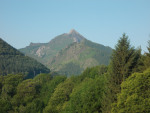
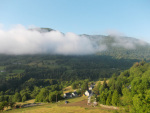
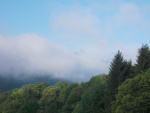
So what does a writer do on the last day of a writing residency at Arras-en-Lavedan?
Easy: instead of doing one research trek, the keen writer does two. Especially when it’s so misty that there is zero visibility at the top of the mountain.
[image error]The first trek took me to the Col d’Arras, where I was sure I’d be able to find a path onto what looked like summer pastures under the Pic d’Arragnat. I wanted to know whether Eole, my protagonist, was hanging around up there.
Perhaps he was. But with heavy bracken vegetation and little grass, I didn’t think it was likely. OK, I admit I wasn’t very persistent. Nor would you be if you heard a kind of growly-barky roar in the bushes and you were very much alone on the mountain.
I hot-footed it back down the non-path, got lost, panicked, struggled over a barbed wire fence and landed on my butt in the mud. I felt much better on the other side of the fence, despite the ripped trousers, and even a bit silly. After all, I could easily have defended myself with my swiss army knife. Couldn’t I? That’s what the bloke in the shop said, anyway.
[image error](Don’t tell my sisters about this: they already split their sides laughing the time, aged 10, I was chased by a herd of cows and ended up clinging to a pole in the middle of a field).
As I write this, I’m listening to brown bear noises on Youtube, and I must admit that the noise is exactly what I heard. Though I guess that’s like looking up illnesses on the Internet to check your symptoms.
On the subject of bears in the Pyrenees, the original race of Pyrenean brown bear died out and Slovenian brown bears were introduced in the 1990s. In 2016 there were 39 bears, of which 2 in – omigod – this area… perhaps its just as well I’m leaving tomorrow! And, reading on through my informative source, if you come face-to-face with a bear you should retreat progressively. Not panic and run. Oh dear.
My Col d’Arras mission had aborted but, happily unaware of the real possibility of meeting a bear, I decided to attack the mountain from further along. There was definitely a path from Arcizans-Dessus up to the Col de Liar, and it passed straight through the said pastures.
Arcizans-Dessus is a tiny village that hugs the flank of a mountain – and boasts 22 watermills. Here are a few of them, lining the Anisaous stream and looking like a Pyrenean version of a housing estate. Some of the cute mills have been restored as cottages, while one serves as a demonstration mill.
The photo below resumes my morning’s research.
[image error]It took me an hour and a half of walking up steep z-bends to reach the silent, deserted Col de Liar. I did hear the eerie ring of bells through the mist on my way up, and there was a cold bonfire spot in the flat land at the top – but there was no sign of Eole and his sheep.
At least I determined that what looked like lush green pastureland from a distance was actually bracken (animals don’t eat bracken), so I guess that’s why this land isn’t grazed.
Coming back down, I was struck by a change in the mist. High up, its cold fingers creep down your back, soak your hair and drip dewdrops onto your eyelashes. But lower down it feels warm and steamy, like a Turkish bath, and the sappy, green tang of bracken gives way to the sweet aroma of elderflower. I’ve never experienced this with mist before – so my morning wasn’t a total waste of time, after all.
Back in the village I visited the church (Eole’s mum is dead religious) and found this guy sitting outside looking at MY mountain. He was made by Pedro Frémy, who also made the village carousel I mentioned in Day 6’s post as well as the other metal beasties around the Maison des Arts. Cute, eh?
Finally, I went to Le Kairn for my 5pm talk about my novel Tree Magic. Once again, I had to struggle through the crowd to get inside (actually, there was a crowd, but they weren’t interested in me).
It was lovely to catch up with my Lumineuse writing group friend Min, and I was delighted to see Bob from Laguépie, who I met at the Parisot Festilitt last year, and who had driven for 5 hours to see me.
[image error]Maybe they’d heard I’d be serving Pineau after the talk?
Pineau is the traditional aperitif in the Cognac area, and I’d brought a bottle for a farewell drink with all the lovely people who have hosted and befriended me this week: Françoise Gourvès, stained-glass artist extraordinaire and also my host at the Maison des Arts; multi-talented Karine from Le Kairn; Dominique Gainza with the strong, cheese-stirring arm muscles from the Val d’Azun sheep&goat farm; and Véronique the costume queen.
Many thanks to you all, and also to those who couldn’t make it: Alex from the mairie & Maison des Arts, Pascal Gainza, Valentine from Le Kairn, Caroline the costume-maker, Charles the Mayor and all the individuals who answered my (sometimes strange) questions.
And thanks to you who have followed these writing residency blog posts and those of you who came to my talks.
I’ll calm down now, and go back to my monthly posting habit.
[image error]Bye-bye, Arras-en-Lavedan. I’ll be back to say hello (with more bottles of Pineau) before too long.
October 3, 2020
Day 7: Twilight in the Pyrenees
Writing Residency Day 7 – June 2017
[image error]What have Transylvania and the Pyrenees got in common?
It’s easy to find an answer, but can you find my answer? Admit it, you’re struggling, aren’t you?
The answer is Dracula: vampires (hence this post title), although unfortunately not of the Robert Pattinson variety.
Of course, Dracula is no more indigenous to the Pyrenees than marmots and granite, but this summer, from 25th July to 6th August 2017, you will find the Prince of Shadows at[image error] Gavarnie.
The theatre company Fébus have been producing outdoor plays with the Gavarnie cirque as a backdrop for 10 years, including Le Cid and Beauty & the Beast.
This year, they’re preparing their own version of Bram Stoker’s novel with their 12 actors, and I was lucky enough to be party to one of their preparation meetings. This involved the costumes, which Véronique Strub has been in charge of for the last 5 years.
If you’ve followed my writing residency posts, you’ll know that Véronique and her assistant Caroline are on a residency here at the Maison des Arts with me. This means that instead of writing in my room in the company of my mountain, I can be distracted and learn all about costume making instead. For a future story, of course. Everything counts as work when you’re a writer.
[image error]I was astonished by the rail of clothes already installed, particularly by the flowery frock. I expressed my surprise to Caroline.
“That’s Dracula’s summer dress,” she said.
And I knew we would get on well together. (I was later told that the dresses had just been stocked there in transit for some sale).
Today’s meeting was with Fébus production & admin boss, Anne-Lise. On the table were the sketches Véronique and Caroline had produced so far, and they proceeded to explain their ideas to Anne-Lise.
Caroline has costume-making qualifications, and told me, as she modified her sketches in line with the discussion, that drawing was an important part of her course.
Véronique has done a huge amount of research, including collecting Balkan costumes on Pinterest and visiting the scene of the play so she knows how close the audience will be. This is vital for dimension decisions.
She has, of course, read Bram Stoker’s novel, concentrating on descriptions of the characters and their clothing. She even pulled out a Dracula picture book at one point during the meeting.
[image error]I was surprised to see to what extent the costumes were designed according to the physical build and the personalities of the actors. One character is new, added by scriptwriter and director Bruno Spiesser, and it was obvious that this made it more difficult to create a costume for her.
Bruno’s script was to hand, as was a summary of each act, showing who was on stage for each scene. As I listened, I realised that not only the physique but also the physical actions of each actor must be taken into consideration for the design.
For example, the vampires, who have to crawl on the ground at one point, have knee protections incorporated in their leggings. And the material covering their arms must be solid enough to take the weight of the wing supports.
Even the colour of Dracula’s climbing rope posed a problem, as its fluorescent colours didn’t match the décor.
Other parameters to be taken into account include the lighting, since a spotlight on a distinctive part of a costume can help the audience understand what’s happening.
Most surprising of all – yet completely logical, having heard the discussion – was how the style of costume has to correspond to the style of any music the actors play.
All in all, I realised how important it is for the costume makers to be involved with all parts of a play, from music to décor to the stage movements. With a fabric budget of 3000€ and three experienced costume makers working from now until 25th July, the visual side of the show, at least, looks promising.
[image error]If you fancy seeing the show, contact www.festival-gavarnie.com. There’s even a shuttle bus from Pau laid on for those who reserve in advance.
It was all very well sitting indoors with sewing machines and mannequins, but outside it was 30°C and the air smelt of newly-cut hay. I left the seamstresses and went to walk and think of writerly things in the shade of the forest above the little village of Sireix.
Since Eole and his sheep weren’t around, I took the opportunity to admire some beautiful trees, some curious insects, an interesting man-made feature – and some rare flowers, thanks to a botanical group I bumped into.
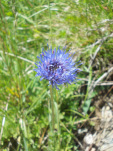
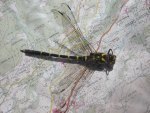
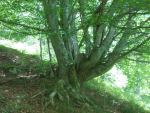
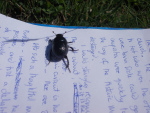
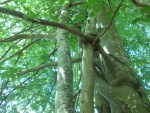
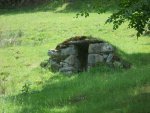
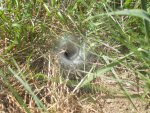
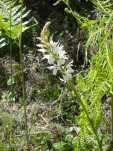
See you tomorrow for the final day of my writing residency.
October 2, 2020
Day 6: Stories of Art and Legend
Writing Residency Day 6 – June 2017
[image error]This was my view when I opened my shutters today. I almost jumped out of the window, I was so desperate to get outside and melt into the mountains.
But first I’d been invited on a guided visit of the contemporary art circuit in Arras with Alex, the cultural specialist at the mairie.
He was doing a special tour for Manoell Bouillet, who is going to use the circuit as a basis for a children’s writing workshop. This is an activity I’d love to offer, one day, so I was intrigued to see how Manoell built her project.
I’m a fan of guided visits, as I explained in my blog post Can I Waste Your Time?. At first sight, the exhibits in the village are pleasant to spot, but it’s not until you listen to a tour guide that you really look at and appreciate them. Unfortunately for non-French speakers, Alex doesn’t do the visits in English.
The theme of the circuit is the village’s heritage, and it is designed to make us think about what we have inherited – and what heritage we’re leaving future generations.
[image error]The visit began at the garden beside Le Kairn, which is NOT a private garden belonging to the bistro-bookshop. There are two exhibits here, and you can enter freely.
The first is a favourite with children. This pedal-powered ‘Carousel of Legends’ was created from scrap metal by local artist Pedro Frémy in collaboration with Richard Rewers. Richard is one of the members of La Machine, which is famous for its huge metallic animals that tour festivals in France and is based in Nantes.
Alex brought the legends to life with his storytelling. The Lake Isaby snake and Le Bécut (Cyclops) come from traditional Pyrenean legends, while the Ferme Andriu goat comes from a village legend. All of them feature local geography and monsters, and can be traced back to glaciation and the dangers of the mountains.
It’s interesting to see how legends change over time, each storyteller interpreting and modernising the story so that it appeals to new audiences. This is a form of living heritage, and Manoell had ideas of using Chinese Whispers in her workshop to demonstrate this point.[image error]
The next landmark is one you can’t miss: a marmot pushing (or retaining?) a rounded granite rock on top of a hillock, surrounded by circular beds of fruit bushes. You definitely need a guide to understand that this exhibit is all about what belongs in the valley and how long we should live in a place before we can consider we belong.
[image error]Let me explain. The hillock is a drop of water falling into a lake and the circular gardens and ramps are the ripples that emanate from it.
The marmot is a popular symbol of the Pyrenees – yet it isn’t indigenous; it was brought in from The Alps. Likewise, the Val d’Azun is largely limestone. The lumps of granite we can find – such as the Pierre du Balandrau in Argelès-Gazost – are erratics, dropped by the glacier when it retreated.
The Val d’Azun is a hanging valley, and was once under 600m of ice. And did you know that the Lac de Lourdes is the furthest glacial lake from this glacier?
Both the marmot and granite are ‘foreigners’ in the valley, yet they are so integrated that they’re often chosen to represent it. There’s a lesson there!
[image error]The visit continued along the route of the black signs. These 26 signs, in black and pink (pink is the extension in the lower part of the village) draw your attention, via a quiz, to diverse landmarks in the village.
If you are disappointed because some don’t highlight the most aesthetic features, this is a normal reaction. It’s deliberate. We’re being encouraged to look at objects we don’t normally notice, such as fences and old TV aerials. These pollutants are part of the heritage we’re leaving future generations.
I won’t describe all the exhibits, but I liked ‘Birth of the Globes’. These three works were created by three different artists on the theme of how man continues Nature’s work. We’re talking about buildings, here, which is why the materials used are wood, stone and clay. If you do the guided visit, ask Alex how the tree and the granite stone arrived here.
The visit finished at the labyrinth outside the church, where I learnt about some original uses of labyrinths in France.
One use was for people to take a meditative walk to the centre (there were no dead ends) and prepare themselves spiritually to meet God before entering church.
Another type of labyrinth was used by the Compagnons du Devoir (an organisation for developing manual skills, dating from the Middle Ages), who used a labyrinth to check the people entering a site. The bona fide workers would pass through in minutes, while imposters would be lost in the dead ends.
Many labyrinths have been destroyed – and the purpose of this one is to make us think about the heritage we don’t pass onto future generations.
It was great fun to work with Alex and Manoell. As we walked, we brainstormed ideas for exploiting the exhibits to create fun and meaningful writing exercises for kids. I’d love to participate in one of her workshops.
After such a thought-provoking morning I headed up to the Col des Bordères – the site of Pascal Gainza’s summer pastures – and took a delightful stroll with my protagonist Eole.
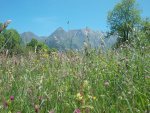
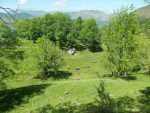
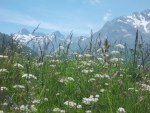
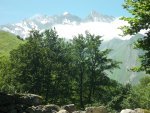
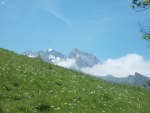
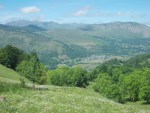
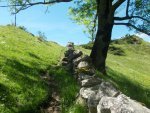
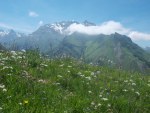
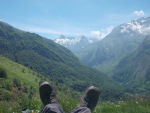
We went up to the Pic de Predoucet, where I spent the afternoon writing, mountain-spotting and watching clouds sneak in from backstage and dress the peaks…
…Which reminded me of costume designers Véronique Strub and Caroline back at the Maison des Arts. Now they’ve got rid of the two dead birds they found in the storeroom they’re busy with their pencils and mannequins.
But more about that tomorrow.
October 1, 2020
Day 5: In Pastures High
Writing Residency Day 5 – June 2017
Today I risked my life for my protagonist.
[image error]I would have been perfectly happy to sit and write at my desk all day, looking at the shy mountain from my window.
That’s what I did do until lunchtime. Then my protagonist – let’s call him, say, Eole – woke up. He’s a teenager, which explains the late rising.
“Let’s go climb,” he said. “Got to check on the sheep.” (EDIT for reblog Sept 2020: No. No, no no. Eole wouldn’t say that at all. Never mind.)
It was nice to have some active company rather than the usual passive paper characters. My boots had dried out, the sun was kind of shining in parts of the valley and I had promised him we’d go out together today.
[image error]So off we went in the car to Aucun, then up the hairpin bends to the Col du Couraduque (1367m).
Eole’s weekend task is to check on the family’s flock of ewes, which graze up on the mountain pastures above the treeline from June to September. He has to check their feet, spray antiseptic on any cuts etc., and if any are hobbling too much he brings them back down to the valley.
I was relieved to discover that mountain roads are far less scary when you’re driving than when you’re a passenger. (I was in tears last year when my partner drove us between the Col du Soulor and the Col d’Aubisque in a thick mist. As passenger, I was on the steep slope side of the road, which fell into swirling white nothingness. And he was going far too fast at 30kmh).
I parked at the Col, and Eole and I walked towards the rocky ridge.
“Just forget I’m here,” I said as I followed him up the path.
I think that was my error. Because – unusually for a teenager – he did exactly what I suggested.
Why is it that teenagers walk at the same speed as grandparents when they’re in town, but as soon as they’re on a mountain they race up it?
I was trying to take photos – so that we would remember the scenery when we’re back in Cognac and Eole returns to his passive state on paper – which meant I was much slower than him.
[image error]On and on Eole walked, higher and higher into the pastures until we found his sheep, grazing in a loose group and clanging their bells as they walked (yes, I know those are cows in the photo…).
To begin with, all was well. Eole threw himself down in the springy, heathy grass and gazed upwards, while I admired the flowers, insects, hoofprints – anything that was firmly on the ground. Above us, clouds skimmed the rocky heights, and he seemed fascinated by them.
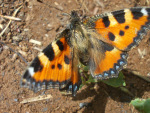
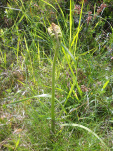
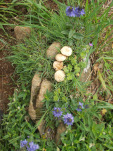
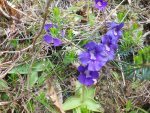
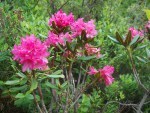
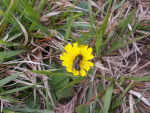
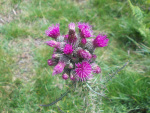
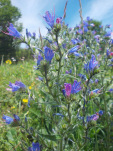
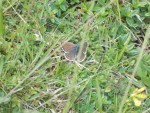
But the sheep kept wandering off and climbing higher. Eole followed. I followed Eole, taking pictures and jotting down notes as I went.
At one point I saw the following sign: ‘Passages Délicats’, which translates as ‘dangerous paths’.
Last time I saw this sign, I nearly lost my daughter (flesh and blood, not a story character) down the side of a mountain, so you can imagine I was a little nervous. I mean, Eole wasn’t exactly going to throw me a rope or call the emergency services if I had an accident, was he? And there was nobody else about.
I suggested we could perhaps take the forest variant, but he just shrugged and jerked his head to the unperturbed sheep. “No grass in the woods.”
[image error]So on we went, me looking nervously down at the steep drop to one side and Eole looking up at the sky.
I was just getting used to it when we arrived at a ridge, a rocky crête, and there were suddenly two steep drops.
By now we were pretty high, and I noticed some birds of prey circling. A helpful information sign lower down had mentioned that Griffon vultures fed on dead animals up here, so this wasn’t reassuring either. All it would take was a slipping foot as I crouched to photograph a butterfly.
At which point I slipped
And rolled
A little.
Grabbed grass
And very quickly came to a standstill.
Strangely, I felt better after this. I threw myself down (well, lowered myself gently) into a safe-ish position and followed Eole’s example of looking up and around instead of down.
[image error]The view was stunning. I tried to remember the names the old man (see my previous post Spying and Lying) had given me and pin them on the peaks. There’s a quality to the silence – when combined with the cold, thin air and the view – that tastes of freedom.
I started to understand why Eole likes it up here; why he’s the one in his family who deals with the sheep all summer.
But I think there’s an additional reason why Eole comes up here. I think he has a secret.
Anyway, I let Eole do his stuff with the sheep, and, as I watched him, I realised that he needs a sheepdog.
The clouds were blackening, so I left Eole up there with his sheep and made my way down, having agreed to meet him tomorrow afternoon in a different pasture with a different flock of sheep.
[image error]Back at the Maison des Arts a plastic bag was waiting on the doormat outside the door. A present? For me? I picked it up.
Inside were two freshly dead birds.
I flicked through my knowledge of French superstitions and witchcraft, to no avail. Puzzled, I left them there and opened the door.
A lady was waiting on the stairs.
“Hello,” I said.
But she didn’t reply.
Well, she wouldn’t, would she? Not without a head.
[image error]Upstairs, three of her comrades were huddled together by my door: naked, beautiful – and also headless.
There’ll be no sleepwalking for me tonight.
***
Thank you for reading right down to here. I’d just like to remind you that I write fiction, so there’s no need to take everything in this post as being 100% true…

